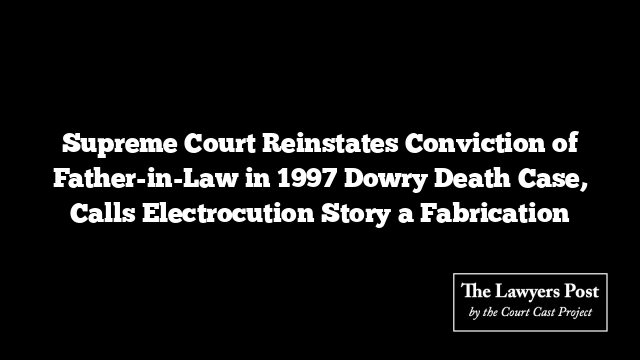The Supreme Court has overturned the acquittal of a man accused of murdering his daughter-in-law nearly three decades ago, restoring his conviction after concluding that the evidence left no room for doubt about his guilt.
A Bench of Justices Sanjay Kumar and Alok Aradhe set aside the Madhya Pradesh High Court’s 2010 order that had exonerated the accused, observing that the acquittal stemmed from a serious misreading of the record. The judges held that while an acquittal carries a presumption of innocence, it can still be reversed if the appreciation of evidence is flawed.
The case dates back to December 1997, when the young woman was found dead inside her matrimonial home. Her father-in-law claimed she had died of electrocution while ironing clothes. But the medical report told a darker story—she had been strangled, and the burn marks on her body were inflicted after her death to disguise the crime.
The trial court had originally convicted the father-in-law for murder, cruelty, and destroying evidence, while finding the husband guilty of dowry death. Years later, the High Court acquitted both men. When the State challenged the decision, the Supreme Court had earlier refused to interfere with the husband’s acquittal, narrowing its review to the father-in-law.
Reinstating the trial court’s verdict, Justice Aradhe wrote that the circumstances surrounding the death clearly pointed to homicide. The woman had died inside the family home under the accused’s control; he was present at the time, as confirmed by his own FIR. His claim that he had stepped out to the fields had no independent support. The Court also took note of the false report of electrocution and the strained family relations over dowry demands.
Each of these elements, the Bench held, formed an unbroken chain leading to only one conclusion—the father-in-law was responsible for the death. The Court invoked Section 106 of the Evidence Act, noting that when a crime occurs inside a home, the person in control of that space bears the burden of explaining what happened. His failure to do so, coupled with an attempt to mislead investigators, strengthened the prosecution’s case.
“The story of accidental electrocution was nothing but a deliberate fabrication,” the judgment said, affirming that the prosecution had proven beyond reasonable doubt that the accused, Janved Singh, strangled his daughter-in-law and attempted to conceal the crime.
With that, the Supreme Court allowed the State’s appeal, reinstating his conviction nearly 28 years after the crime.





